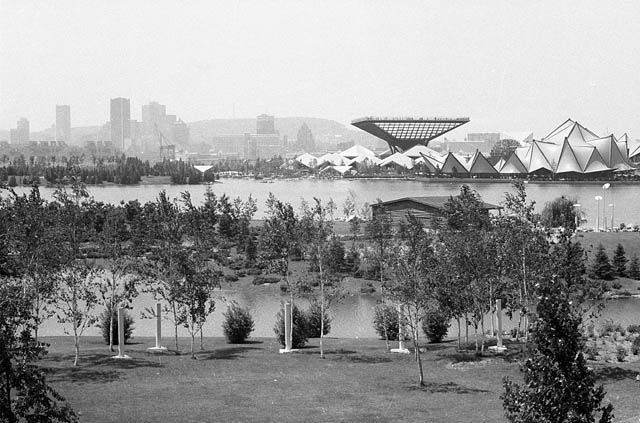| WEST'S PAVILION PROVIDES STARTLING
CONTRAST
Amid Expo's Avant-Garde Jungle Of Steel - the Hills of Home By Marjorie Nichols, The Ottawa Journal MONTRÉAL - Amid the architectural avant-garde of Expo's steel, chrome, plastic, glass and brick pavilions is what appears to be a single-thatched hill with trees growing on top. It is the $1,300,000 pavilion of Western Canada -- British Columbia, Alberta, Saskatchewan and Manitoba -- and its displays are as unique as its outward appearance. GIANT SCULPTURE There is a mechanized, 11-ton sculpture by an Edmonton artist that was built from pieces of 23 machines that are manufactured and used in the west. The pretty hostess flips a switch and the "sculpture" goes into motion -- the rock picker parts flail forth, the grain auger portion grinds into gear and the art show is in full swing. Unlike most displays in other of the pavilions, Western Canada's appeals to the sensory as well as the visual perceptions. As the visitor walks through the areas depicting the major industries of the west, he is surrounded by the smells of freshly cut hay, fish, oil and gas, cooking green beans and sawed logs. There are no windows in the pavilion. Lighting is provided in most of the display areas by brightly flashing, colored bulbs, and most of the walls are black, giving a cave-like effect. But all this, according to the hostess, was designed to guarantee undivided attention to the displays. Altogether there are nine display areas, or "capsules" in the pavilion, each depicting some facet of each of the four provinces' major industries. MINE SHAFT A dimly lit mine shaft, complete with timber shorings and rock-like walls and ceilings, three stuffed Hereford heads, a field of Saskatchewan wheat and a dozen British Columbia Douglas fir represent the mining, farming and lumbering industries. In the centre of the pavilion is a round, open-air area with a giant, fully-loaded logging truck set in natural surroundings. The exterior design of the pavilion is symbolic of western topography. The roof of the conical shaped building slopes up from ground level to a height of about 30 feet, symbolizing the terrain from the prairies to the Rocky mountains. From the vantage point of Expo's minirail, Ontario's huge pavilion looks like a series of inverted pyramids, covered with tents and surrounded by a modern stone hedge. Inside, the impression is that of a combined museum of modern and historical art.
Photo credit: © National Archives of Canada A view of Expo 67 with Montréal in the background The exhibits, most of which are encased in rectangular, glass boxes, trace the industrial and cultural developments of the province from 1900. There is everything from the female wardrobe of 1900 to the latest transistor radio and a life-size robot. MORE SCULPTURES There are 14 modernistic sculptures by Ontario artists -- each enclosed in an individual glass cage. And there are a number of pieces of children's art suspended from the roof. But, except for a huge artificial waterfall the visitor can view from a vantage point directly overhead, there is nothing particularly unique within the display areas. The entire display is covered in mauve carpeting, and the ramps and grounds around the pavilion are covered in grey, crushed stone. The pyramid-shaped roofs, made from opaque vinyl glass fibre stretched over steel, don't quite reach to the wooden rectangular bases of the pavilion, providing visitors with a panoramic view of the rest of the pavilions. One outstanding feature of Ontario's pavilion, however, is its 570-seat circular theatre, where the visitor is treated to a preview showing of a 20-minute film. - End of article. Copyright by The Ottawa Journal, April
28, 1967. All rights reserved.
|

